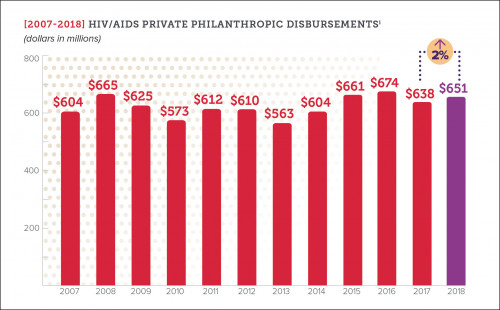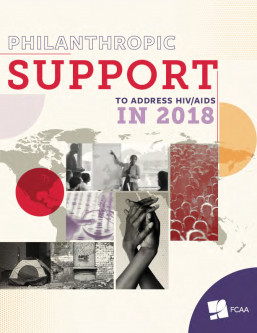Private philanthropic funding for HIV-related causes increased $13 million between 2017 and 2018. At first glance, this might seem like good news. But a deeper dive into the global data reveals a troubling trend: Funding to fight the epidemic has “remained relatively flat.” Or worse: The numbers illustrate “the reality of the steady retreat from HIV by broader philanthropy.”
That’s how John L. Barnes, executive director of Funders Concerned About AIDS (FCAA), interprets findings from the group’s latest report. Titled Philanthropic Support to Address HIV/AIDS in 2018, it’s the 17th annual examination of private funding for HIV-related causes.

Detail from the report “Philanthropic Support to Address HIV/AIDS in 2018”FCAAIDS.ORG
The report gathers data on grants listed by nearly 80 funders that, together, represent about 93% of total funding. The report also looks at information about grants on websites, 990 forms, annual reports and similar documents.
Big numbers from the report include:
- $651,318,375—total philanthropic giving to HIV/AIDS in 2018; this represents a 2% ($13 million) increase from the previous year
- 693—number of funders
- 7,029—number of grants to about 3,500 grantees
The top 10 philanthropic funders of HIV/AIDS-related causes include:
- Bill & Melinda Gates Foundation
- Gilead Sciences
- Wellcome Trust
- ViiV Healthcare
- MAC Viva Glam Fund
- Elton John AIDS Foundation
- amfAR, The Foundation for AIDS Research
- aidsfonds
- Conrad N. Hilton Foundation
- Children’s Investment Fund Foundation
According to the report, notable changes in 2018 include:
- PrEP: Funding for pre-exposure prophylaxis increased 16% to $36 million
- United States: For the fifth year in a row, the country received a record high of funding, this time totaling $200 million.
- Older adults: People older than 50 saw a 627% increase in funding, growing from $3 million to $22 million. That marked the largest jump in funding for a specific population group.

Cover of the FCAA’s latest reportFCAAIDS.ORG
In the report’s overview, the authors write:
A key headline from this year’s report—much like previous years—is that HIV-related private philanthropy is concentrated among an increasingly small number of funders.… Notably, the 2018 increase was mostly driven by a few funders in that top 20, in particular by a $29 million rise in giving from the Wellcome Trust. To further illustrate the concentration at the top, the threshold for making it onto the top 20 list has dropped below $4 million, whereas only two years ago a funder had to give over $7 million to qualify for the list.
The almost 40-year fight against HIV and AIDS has been marked with a series of evolving strategies, priorities and deadlines. With each scientific or treatment breakthrough came the hope that we were closer to the end of the epidemic. This “ending AIDS” paradigm was intended to grow resources and seize an opportunity to leverage tremendous progress. But even if the end of AIDS is scientifically possible, we need to examine if that framing is spurring resources or breeding complacency. Further, as we increasingly recognize the intersectional nature of HIV, we better understand our task not just as stopping a virus, but also addressing the social and political factors that have fueled it.
You can download the free report here and read a blog post by Barnes here.







1 Comment
1 Comment